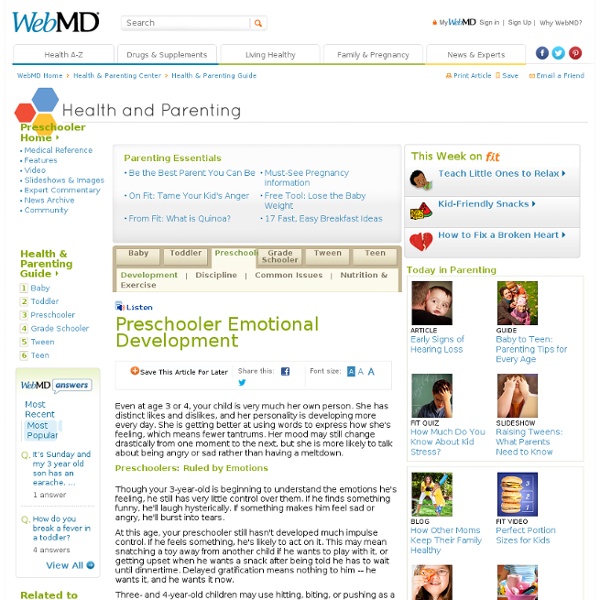Emotional Development in Preschoolers: From Age 3 to 5

http://www.webmd.com/parenting/guide/preschooler-emotional-development
Emotional Development in Preschoolers
Your three-year-old’s vivid fantasy life will help her explore and come to terms with a wide range of emotions, from love and dependency to anger, protest, and fear. She’ll not only take on various identities herself, but also she’ll often assign living qualities and emotions to inanimate objects, such as a tree, a clock, a truck, or the moon. Ask her why the moon comes out at night, for example, and she might reply, “To say hello to me.” From time to time, expect your preschooler to introduce you to one of her imaginary friends. Some children have a single make-believe companion for as long as six months; some change pretend playmates every day, while still others never have one at all or prefer imaginary animals instead. Don’t be concerned that these phantom friends may signal loneliness or emotional upset; they’re actually a very creative way for your child to sample different activities, lines of conversation, behavior, and emotions.
Emotional Development in Preschool Age Children
Three-, four-, and five-year-olds express a wide range of emotions and are able to use appropriate labels such as mad, sad, happy, and just okay to differentiate their feelings. During these preschool years, children’s emotional states are very situation-specific and can change as rapidly as they switch from one activity to another. As children develop from three-year-olds into five-year-olds, there is an increasing internalization and regulation over their emotions. As three-, four-, and five-year-olds acquire new cognitive and language skills, they learn to regulate their emotions and to use language to express how they and others feel.
brighthubeducation
written by: Kara Bietz • edited by: Tania Cowling • updated: 9/11/2012 Social-emotional development is often harder to observe than cognitive or motor development in preschool children. Learn to use observation to evaluate the milestones of emotional development.
Emotional Development - Preschoolers
Preschoolers show their growing independence, initiative, and creativity by wanting to try new things and make new friends. Some children will be quick to do this on their own, but others are more comfortable taking their time. Their approach will depend a lot on their temperament.
Related:
Pre-K
Related:



